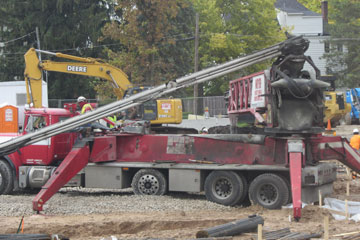
Transporting ready mix concrete efficiently and safely is crucial to ensuring the success of construction projects. Ready mix concrete offers convenience and high-quality results, but proper handling and transportation are essential to maintain its properties and usability. In this article, we will discuss seven important things to remember while transporting ready mix concrete to help you achieve optimal results.
Plan Ahead:
Before transporting ready mix concrete, careful planning is essential. Consider factors such as the distance to the construction site, traffic conditions, and the volume of concrete needed. Adequate planning ensures that the necessary resources, such as transportation vehicles and personnel, are available at the right time and in the right quantities.
Choose the Right Transportation Method:
Selecting the appropriate transportation method is crucial for the safe delivery of ready mix concrete. Depending on the project's requirements, you can choose between traditional drum mixers, truck-mounted conveyors, or pumping systems. Each method has its advantages and limitations, so consider the project's specifics and consult with experts to determine the best option.
Maintain Proper Concrete Consistency:
Ready mix concrete must maintain its consistency during transportation to preserve its workability. Concrete that becomes too stiff or starts to set can cause problems during pouring and finishing. To ensure consistency, use specialized mixers equipped with rotating drums or agitators that keep the concrete in motion throughout the transportation process.
Control the Concrete Temperature:
Temperature plays a vital role in maintaining concrete quality. Hot weather can accelerate the setting time, while cold weather can cause it to set too slowly. Both extremes can affect the concrete's strength and durability. Implement measures such as temperature-controlled mixers, insulating blankets, or additives to regulate the concrete's temperature during transportation.
Minimize Water Addition:
Avoid adding water to the Ready Mix Concrete during transportation unless explicitly instructed by the manufacturer or engineer. Extra water may compromise the concrete's strength, durability, and workability. If water is required, consult the manufacturer or supplier for guidance and follow their instructions precisely.
Secure and Protect the Load:
Properly securing the ready mix concrete load is crucial to prevent spillage, segregation, and damage during transit. Use appropriate tie-downs, tarps, or covers to keep the load secure and protected from external factors such as wind, rain, or debris. Regularly inspect the load during transportation to address any issues promptly.
Follow Safety Protocols:
Maintaining safety standards during concrete transportation is paramount to avoid accidents and ensure the well-being of workers and the general public. Adhere to all traffic regulations, including speed limits and weight restrictions. Provide appropriate training to drivers and crew members regarding concrete transportation safety protocols. Ensure that vehicles are properly maintained and regularly inspected to guarantee their reliability.
Conclusion
Transporting ready mix concrete requires careful planning, adherence to quality standards, and implementation of safety measures. By considering the factors mentioned in this article, you can ensure the successful delivery of ready mix concrete to your construction site, maintaining its quality and workability. Following these guidelines will help you achieve optimal results and contribute to the overall success of your construction project.